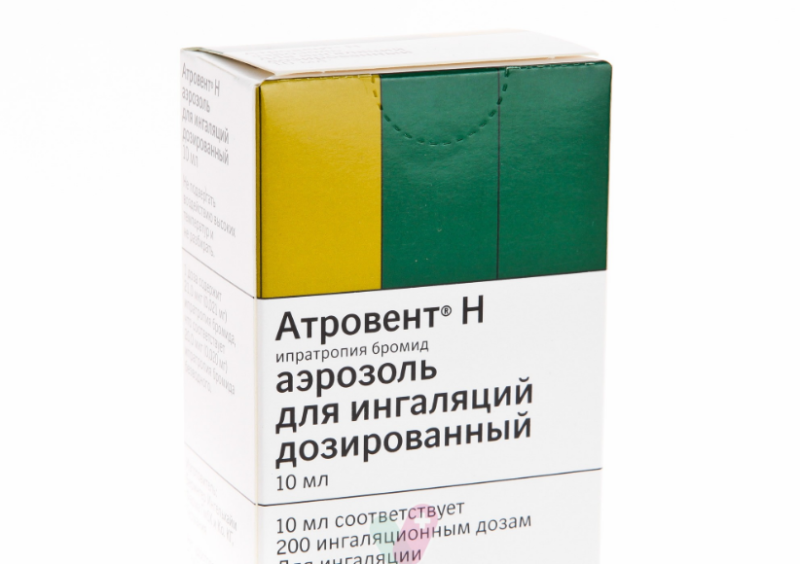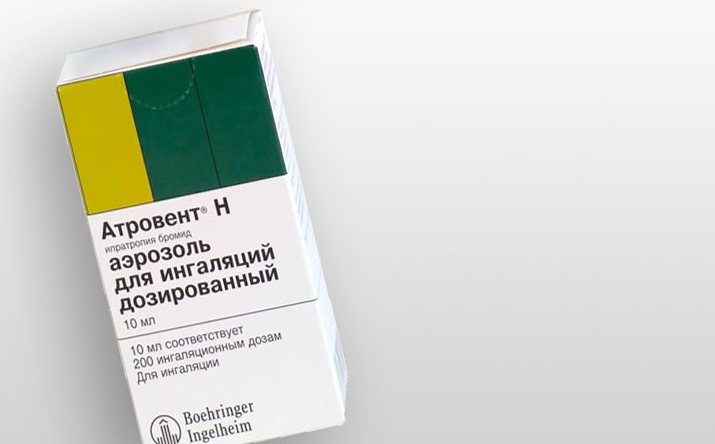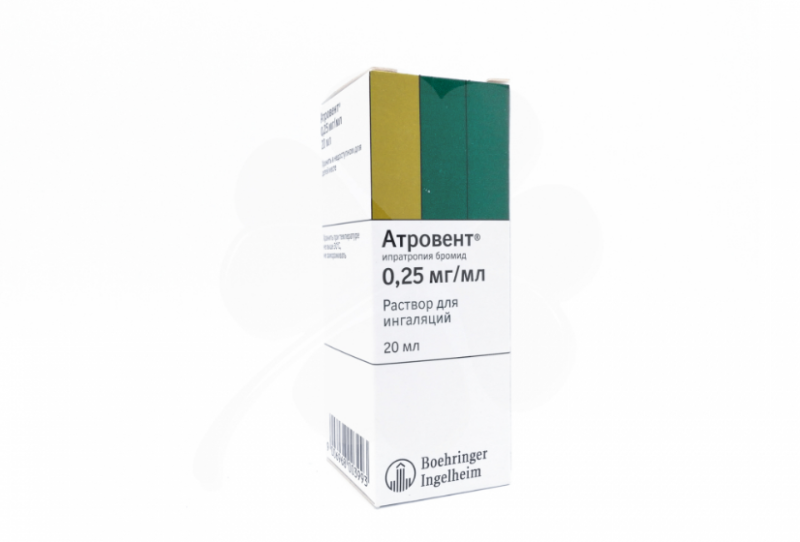In the results of issuing a query in the search bar - "atrovent instruction for use" - all kinds of information are opened. To deal with its reliability, we will be helped by information published in official sources.
Material Content:
- 1 Composition and release forms
- 2 Pharmacological action, pharmacodynamics and pharmacokinetics
- 3 Why is the drug prescribed for adults and children
- 4 Instructions for taking Atrovent for inhalation
- 5 During pregnancy and lactation
- 6 Drug interaction
- 7 Contraindications, side effects and overdose
- 8 Analogies of bronchodilator
Composition and release forms
In the instructions, the medicine is indicated as m-anticholinergic. It acts on contractile tissue of the bronchi, preventing the development of bronchospasm. Choking attacks are suppressed by two convenient forms of medication - a metered-dose spray and a solution compatible with home nebulizers.
The medicine is given the international name "ipratropium bromide", by analogy with the name of its active substance. A single dose of aerosol contains 20 μg of this active compound. In addition to it, the composition contains propellant, citric acid and alcohol, which are mixed in purified water.
The finished composition acquires the properties of a transparent liquid without color and sediment. The medicine is placed in a metal bottle (10 ml), in which increased pressure is created. One container holds 200 single doses.
The bottle is closed with a plastic stopper with an integrated valve. The medicine in the form of an aerosol is assigned the mark "H". The composition of the drug package - Atrovent N aerosol - includes a mouthpiece for individual dosing.
The whole kit fits in the box.The cylinder must be stored under normal conditions, preventing it from overheating or freezing. In this case, the drug will be suitable for three years.
The solution dispensed in glass bottles is used to fill the chamber of a home inhaler. It is a transparent liquid without shades and inclusions, which contain benzalkonium chloride, chelaton III, sodium chloride and hydrochloric acid.
The solution of the active and excipients is brought to the desired volume with prepared water. One bottle of such a tool holds 20 ml of solution. For every milliliter, 0.25 g of ipratropium bromide.
The medicine bottle is made of amber-colored glass. The neck is covered by a polypropylene dropper with a protective, screw-on cap.
Bottles are dispensed packed in a cardboard box. You can store the medicine for up to three years.
Pharmacological action, pharmacodynamics and pharmacokinetics
Ipratropium bromide is a competitive substance in relation to acetylcholine, which transmits a nerve impulse to the receptors of the smooth muscles of the bronchi, causing a spasm. Preventing the release of the neurotransmitter, Atrovent prevents the reflex narrowing of the lumen of the airways.
Bronchial spasm can be a consequence of both internal (obstruction of the lungs, bronchial asthma), and external factors (smoke, cold air). Atrovent remains effective, regardless of the nature of the origin of this phenomenon.
By blocking m-cholinergic receptors, it inhibits the secretion of the glands of the nasal mucosa and bronchi, thereby reducing the number of secretions and facilitating breathing. The effect of inhalation begins to be felt after 5-15 minutes, increases within an hour and in total lasts up to 6 hours.
The action extends mainly to large and medium bronchi. Only a tenth of the inhaled dose penetrates deep into the lungs. The medicine works on an irrigated surface in direct contact. It does not penetrate deep into the tissues and practically does not enter the systemic circulation.
About 70% of the inhaled aerosol is simply swallowed. A fifth of the substance trapped in the intestine leaves with the feces unchanged. The remaining amount immediately breaks down into metabolites and leaves the body in the form of transformed compounds.
5 to 10% of the drug is absorbed from the intestine. In a matter of minutes, it enters the bloodstream. This does not affect health. Bronchospasm stops as a result of local exposure, but not due to the presence of the drug in the blood.
The amount of compound present in the bloodstream is not enough to have a systemic effect. For example, only 500 doses taken at a time can cause tachycardia.
The proportion of the compound that enters the bloodstream comes out with feces and urine with the direct involvement of the liver and kidneys.
Why is the drug prescribed for adults and children
One of the indications is chronic and progressive pulmonary disease, accompanied by obstruction - narrowing of the lumen of the bronchi resulting from irreversible destructive changes. Against the background of this syndrome, the patient suffers from a lack of air.
Atrovent is also effective in diseases of an immunological nature (bronchial asthma), where the main factor in the occurrence of spasm is an allergy or a similar reaction. In this case, the movement of air along the tracheobronchial tree is prevented by edema, which is partially or completely eliminated by the drug.
Lastly, Atrovent is used to facilitate breathing in protracted colds, as well as as a means of preparing the patient for surgery.
It is worth noting that this bronchodilator drug is not the best among first aid for an acute attack of suffocation, since the effect of it does not develop as rapidly as necessary in a similar situation. In terms of speed of action, it is inferior to beta-adrenostimulants used in such cases.
Instructions for taking Atrovent for inhalation
Therapy of respiratory failure by Atrovent should be carried out under the supervision of medical staff. In each situation, the dose of the drug is set individually. In the event of a sharp deterioration in well-being, emergency care should be called.
In aerosol
Atrovent N aerosol in a cylinder is under pressure. To bring the inhaler into working condition, it is necessary to remove the protective cap from it, turn the container over and press the bottom twice.
Next, grip the mouthpiece with the mouth and, while taking a deep breath, press the bottom of the balloon again. As a result, the medicine will be released from the inhaler and into the respiratory tract. After this, you should definitely hold your breath for a few seconds, then exhale and repeat the procedure again.
Unless a special dosage regimen is provided, all patients over six years of age are allowed to do two injections four times a day. More than twelve single doses per day is not recommended. The increased need for a medicine indicates the need for its replacement or supplement with other drugs.
Due to the development of the respiratory system, Atrovent Aerosol is not recommended for children under six years of age. In a child of this age, the procedure itself can provoke bronchospasm.
Aerosol is prescribed as part of maintenance therapy. In acute cases, it is recommended to use the medicine in the form of a solution.
The manufacturer warns that the inhaler that comes with the bottle is suitable only for this product and is not designed for dosing other drugs.
In solution
Atrovent for inhalation is compatible with all home nebulizers. Before refueling the camera, it must be diluted with saline. Depending on the modification of the device, the degree of dilution of the drug may be different.
The solution must be prepared every time again immediately before inhalation. Do not store diluted product. The amount remaining after the procedure must be poured.
Dosage is carried out individually. However, if a special regime is not prescribed, then average standards should be used. During maintenance therapy and in acute conditions, the frequency of administration should be different.
In acute spasm of the respiratory tract:
- for everyone who is older than 12 years old, Atrovent's solution is prepared on the basis of forty drops of the medicine;
- children older than six, but under the age of twelve, are prescribed 20 drops at a time;
- up to six years is allowed to use a dose of 8 to 20 drops.
Inhalations are repeated several times until the patient is stabilized. Their number and the interval between repetitions are determined by the doctor.
At the stage of maintenance therapy, the dosages remain the same. The multiplicity of the procedure is adjusted to three to four times a day.
During pregnancy and lactation
The medicine in the form of an aerosol is prohibited for use in the first three months of pregnancy. The subsequent appointment should be treated with caution. There is no evidence of its safety during pregnancy and breastfeeding. At the same time, laboratory tests of the drug did not reveal its ability to influence the development or formation of the fetus.
The preferred form for pregnant and lactating women is a solution, because during inhalation it is swallowed, absorbed in the intestine and the least amount of medicine enters the bloodstream. However, any such appointment should be dictated by a doctor.
Drug interaction
Long-term interaction of the drug with the drugs of the same pharmaceutical group has not been studied, therefore, their combined use is not recommended.
Beta-adrenergic agonists and cromoglicic acid concurrently prescribed with Atrovent can cause negative consequences.
Combinations with xanthine derivatives, antidepressants, anti-Parkinsonism drugs and quinidine increase the effect of bronchodilator.
Contraindications, side effects and overdose
The tool should not be prescribed to persons with a predisposition to allergic reactions to any of the components of the drug, as well as to derivatives of atropine. Patients with glaucoma, prostate neoplasms and urinary tract conduction disorders should take the medicine with caution, if there is constant monitoring by the medical staff. The same applies to children under six years of age and nursing women.
Most often, taking the drug is accompanied by local irritation - dry mouth, burning in the throat, malfunction of the intestine. Allergic reactions, dizziness, and headache are less common.
From the side of the organs of vision, a violation of the perception of color and distance appears. The cornea and conjunctiva of the eye may swell, characteristic pain, redness and fog in the eyes may occur.
The heart and circulatory organs respond to the drug by increasing and increasing heart rate.
From the side of the respiratory system may appear:
- dry mucosa;
- swelling
- spasms of an allergic nature;
- cough.
Hypersensitivity is manifested in the form of rashes on the skin and itching, accompanied by a rash or without it. Also, one of the undesirable consequences of taking the drug is the delay in urine discharge.
Exceeding dosages can provoke an aggravation of adverse reactions from the respiratory system, such as dry mouth, cough and swelling of the nasopharynx. In this case, there should be a prescription therapy aimed at suppressing the symptoms that have appeared.
Analogies of bronchodilator
The following drugs have the identical composition:
- Ipratropium Steri-Neb, available in the form of a solution for nebulizers;
- Ipratropium Air - an aerosol for fast topical application.
Among the analogues for the main substance, drugs with the addition of phenoterol are found.
These are pharmaceuticals such as the following:
- Astmasol SOLO-Farm - a solution of bronchodilator for inhalation;
- Berodual - for inhalation and marked “H” as an aerosol;
- Inspirax is a metered-dose aerosol.
Atrovent's analogs, like the original drug, are included in the therapy according to strict indications.
The medicine based on ipratropium bromide is a potent substance that must be handled with care. When applied topically, it causes a minimum of harm. However, the main condition for treatment should be strict adherence to medical recommendations.




















